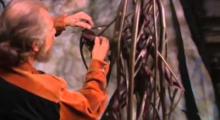Themes
This video shows one method of casting a figure in bronze. First a model is made out of wax, the wax model is divided into sections. Each section is placed in a clay bed. A plaster mould is built up around it. The section of the mould are assembled. Hot wax is pured in to form a thin layer inside the mould
This is repeated until the wax is the desired thickness. The sections are joined together to recreate the original wax figure. A mixture of sand and plaster fills the model, creating a solid core. Wax rods are attached. These form channels to carry the molten bronze and let gases escape. The rods are attached to a wax funnel. Pins are inserted to hold the plaster core of the model in place. A plaster mould is created layer by layer around the wax model. The mould with the model inside is fired in a kiln. The heat melts the wax, which flows out via the funnel. All the wax areas are now empty, ready for the bronze to be poured. The core of the model is still held in place by the pins. Bronze is made from copper, tin and small amounts of other metals. These are heated to about 1,000C.
The bronze is skimmed to remove impurities. The mould is turned upside down. Bronze is poured into the funnel. The bronze flows through the channels to the figure inside the mould. After the bronze has cooled the mould is broken open. The figure and the channels are now bronze. The bronze rods are removed. The pin holes are plugged. The details of the figure are perfected. The surface finish or patina is created using acid and wax.
Produced by the Victoria and Albert Museum, London
Comments
Brought to you by NGADC






